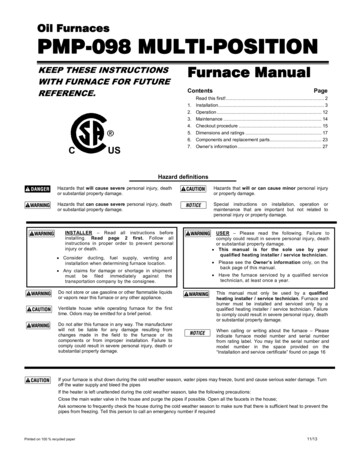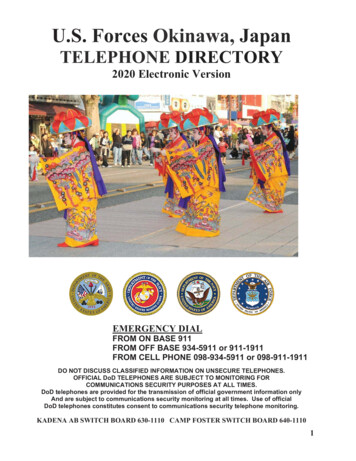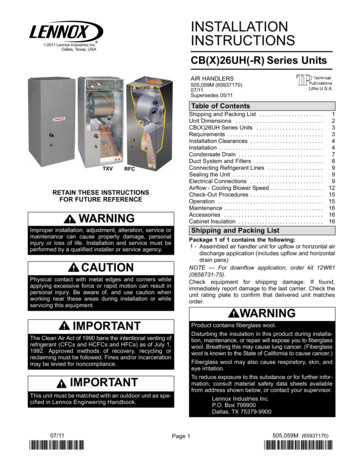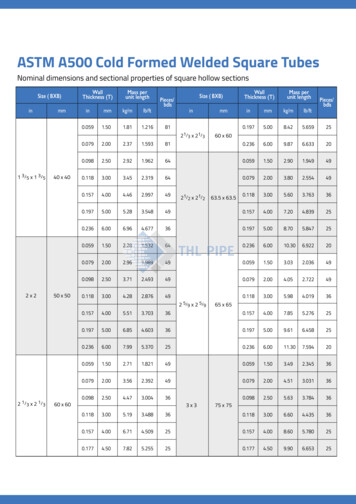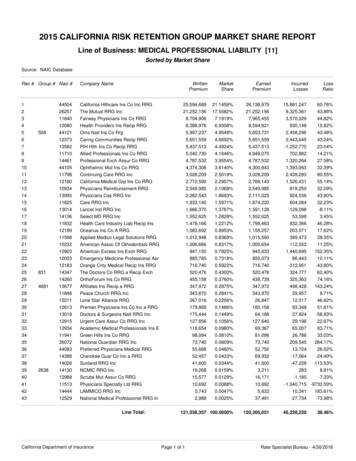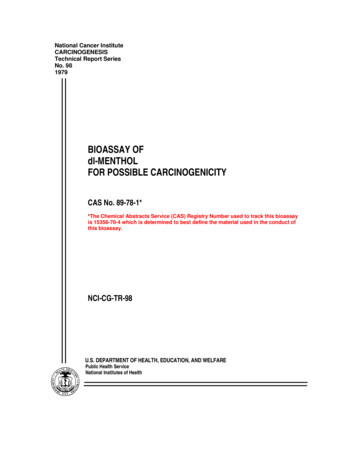
Transcription
National Cancer InstituteCARCINOGENESISTechnical Report SeriesNo. 981979BIOASSAY OFdl-MENTHOLFOR POSSIBLE CARCINOGENICITYCAS No. 89-78-1**The Chemical Abstracts Service (CAS) Registry Number used to track this bioassayis 15356-70-4 which is determined to best define the material used in the conduct ofthis bioassay.NCI-CG-TR-98U.S. DEPARTMENT OF HEALTH, EDUCATION, AND WELFAREPublic Health ServiceNational Institutes of Health
BIOASSAY OFdl-MENTHOLFOR POSSIBLE CARCINOGENICITYCarcinogenesis Testing ProgramDivision of Cancer Cause and PreventionNational Cancer InstituteNational Institutes of HealthBethesda, Maryland 20014U.S. DEPARTMENT OF HEALTH, EDUCATION, AND WELFAREPublic Health ServiceNational Institutes of HealthDHEW Publication No. (NIH) 79-1348
ii
BIOASSAY OFdl-MENTHOLFOR POSSIBLE CARCINOGENICITYCarcinogenesis Testing ProgramDivision of Cancer Cause and PreventionNational Cancer InstituteNational Institutes of HealthFOREWORD:This report presents the results of the bioassay ofdl-menthol conducted for the Carcinogenesis Testing Program,Divisionof CancerCauseand Prevention,NationalCancer(NCI), and.This is one of a series of experiments designed todetermine whether selected chemicals have the capacity to producecancer in animals.Negative results, in which the test animalsdo not have a greater incidence of cancer than control animals,do not necessarily mean that the test chemical is not acarcinogen, inasmuch as the experiments are conducted under alimited set of circumstances. Positive results demonstrate thatthetestchemicalis carcinogenicfor animalsundertheconditions of the test and indicate that exposure to the chemicalis a potential risk to man. The actual determination of the riskto man from animal carcinogens requires a wider analysis.CONTRIBUTORS;This bioassay of dl-menthol was conducted byHazleton Laboratories America, Inc., Vienna, Virginia, initiallyunder direct contract to NCI and currently under a subcontract toTracor Jitco, Inc., prime contractor for the NCI CarcinogenesisTesting Program.The principal investigators for the dl-menthol study were Drs. M.B. Powers and R. W. Voelker . Drs. Powers, C. Cueto, Jr. , and0. G. Fitzhugh were responsible for the selection of the dosesadministered during the chronic study.Dr. Powers prepared areport of the methodology. Ms. K. J. Petrovics was responsiblefor data management and Mr. G. Najarian for animalcare.Histopathologic examinations were performed by Drs. D. A. Banas1and R. H. Habermann* and reviewed by Dr. Voelker, and thediagnoses included in this report represent their interpretation.iii
Animal pathology tables and survival tables were compiled at EG&GInstitute .The statistical analyseswereMason Researchperformed by Dr. J. R. Joiner and Ms. P. L. Yong3, using methodsselected for the bioassay program by Dr. J. J. Gart5.Chemicalsused in this bioassay were analyzed at Midwest Research Instituteunder the direction of Dr. E. Murrill6} and feed letonLaboratories by Dr. C. L. Guytonl and Mr. E. Missaghil.Theresults of these analyses were reviewed by Dr. S. S. Olin .This report was prepared at Tracor Jitco3 in collaboration withHazleton Laboratories and NCI.Those responsible for the reportat Tracor Jitco were Dr. L. A. Campbell, Director of the BioassayProgram; Dr. S. S. Olin, Deputy Director for Science; Dr. J. F.Robens, toxicologist; Dr. R. L. Schueler, pathologist; Dr. G. L.Miller, Ms. L. A. Waltz, and Mr. W. D. Reichardt, biosciencewriters; and Dr. E. W. Gunberg, technical editor, assisted by Ms.Y. E. Presley and Ms. P. J. Graboske.The following other scientists at NCI were responsible forevaluating the bioassay experiment, interpreting the results, andreporting the findings: Dr. Kenneth C. Chu, Dr. Cipriano Cueto,Jr., Dr. J. Fielding Douglas, Dr. Dawn G. Goodman?, Dr. RichardA. Griesemer, Dr. Harry A. Milman, Dr. Thomas W. Orme, Dr. RobertA. Squire , Dr. Sherman Stinson, Dr. Jerrold M. Ward, and Dr.Carrie E. Whitmire.lHazleton Laboratories America, Inc. , 9200 Leesburg Turnpike,Vienna, Virginia.2carcinogenesis Testing Program, Division of Cancer Cause andPrevention, National Cancer Institute, National Institutes ofHealth, Bethesda, Maryland. Tracor Jitco, Inc., 1776 East Jefferson Street, Rockville,Maryland.Mason Research Institute, 1530 East Jefferson Street,Rockville, Maryland.IV
Mathematical Statistics and Applied Mathematics Section,Biometry Branch, Field Studies and Statistics, Division ofCancer Cause and Prevention, National Cancer Institute,National Institutes of Health, Bethesda, Maryland. Midwest Research Institute, 425 Volker Boulevard, Kansas City,Missouri.with Clement Associates, Inc., 1010 Wisconsin Avenue, N.W. ,Suite 660, Washington, D. C.%ow with the Division of Comparative Medicine, Johns HopkinsUniversity, School of Medicine, Traylor Building, Baltimore,Maryland.
vi
SUMMARYA bioassay of dl-menthol for possible carcinogenicity was conductedby administering the test chemical in feed to Fischer 344 rats andB6C3F1 mice.Groups of 50 rats of each sex and 50 mice of each sex wereadministered dl-menthol at one of the following doses, either 3,750or 7,500 ppm for the rats and either 2,000 or 4,000 ppm for the mice,for 103 weeks, then observed for 1 or 2 additional weeks. Matchedcontrols consisted of 50 untreated rats of each sex and 50 untreatedmice of each sex. All surviving rats were killed at 105 weeks andall surviving mice at 104 weeks.Mean body weights of dosed rats and mice were only slightly lowerthan those of corresponding controls.No other clinical signsrelated to administration of the dl-menthol were noted in the dosedA dose-related trend in mortality was observedgroups of animals.only in the female mice. Survival at the end of the bioassay was atleast 62% in all dosed and control groups of animals of each species,and sufficient numbers of animals were at risk for the development oflate-appearing tumors.In male rats, no tumors occurred at incidences which were consideredto be related to the administration of dl-menthol.In female rats, no tumors occurred at higher incidences in the dosedgroups than in the control groups.Fibroadenomas of the mammarygland occurred at lower incidences in the low-dose (10/49) andhigh-dose (7/49) groups than in the control group (20/50), andalveolar/bronchiolar adenomas or carcinomas of the lung occurred onlyin the controls (3/50).In mice of either sex, no tumors occurred in dosed groups eforcorresponding control groups.Itis concludedthat under the conditionsof this bioassay,dl-menthol was not carcinogenic for either Fischer 344 rats or B6C3F1mice.vii
viii
TABLE OF CONTENTSPageI.Introduction1II. Materials and MethodsA.B.C.D.E.F.G.H.3ChemicalDietary PreparationAnimalsAnimal MaintenanceSubchronic StudiesDesigns of Chronic StudiesClinical and Pathologic ExaminationsData Recording and Statistical AnalysesIII. Results -RatsA.B.C.D.IV.19Body Weights and Clinical Signs (Rats)Survival (Rats)Pathology (Rats)Satistical Analyses of Results (Rats)Results - MiceA.B.C.D.34558912131919212325Body Weights and Clinical Signs (Mice)Survival (Mice)Pathology (Mice)Statistical Analyses of Results DIXESAppendix ATable AlTable A2Summary of the Incidence of Neoplasms inRats Administered dl-Menthol in the Diet37Summary of the Incidence of Neoplasms inMale Rats Administered dl-Menthol in the Diet39Summary of the Incidence of Neoplasms inFemale Rats Administered dl-Menthol in the Diet.43ix
PageAppendix BTable BlTable B2Appendix CTable ClTable C2Appendix DTable DlTable D2Appendix ETable ElTable E2Appendix FTable FlSummary of the Incidence of Neoplasms inMice Administered dl-Menthol in the Diet49Summary of the Incidence of Neoplasms inMale Mice Administered dl-Menthol in the Diet51Summary of the Incidence of Neoplasms inFemale Mice Administered dl-Menthol in the Diet.55Summary of the Incidence of NonneoplasticLesions in Rats Administered dl-Menthol in the Diet59Summary of the Incidence of NonneoplasticLesions in Male Rats Administered dl-Mentholin the Diet61Summary of the Incidence of NonneoplasticLesions in Female Rats Administered dl-Mentholin the Diet66Summary of the Incidence of NonneoplasticLesions in Mice Administered dl-Menthol in the Diet71Summary of the Incidence of NonneoplasticLesions in Male Mice Administered dl-Mentholin the Diet73Summary of the Incidence of NonneoplasticLesions in Female Mice Administered dl-Mentholin the Diet77Analyses of the Incidence of Primary Tumorsin Rats Administered dl-Menthol in the Diet81Analyses of the Incidence of Primary Tumorsin Male Rats Administered dl-Menthol in the Diet.83Analyses of the Incidence of Primary Tumorsin Female Rats Administered dl-Menthol in the Diet.90Analyses of the Incidence of Primary Tumorsin Mice Administered dl-Menthol in the Diet95Analyses of the Incidence of Primary Tumorsin Male Mice Administered dl-Menthol in the Diet.97
Table F2Appendix GAnalyses of the Incidence of Primary Tumorsin Female Mice Administered dl-Menthol in the Diet.102Analysis of Formulated Diets fordl-Menthol Concentration107TABLESTable 1Table 2Design of dl-Menthol Chronic Feeding Studiesin Rats10Design of dl-Menthol Chronic Feeding Studiesin Mice11FIGURESFigure 1Figure 2Figure 3Figure 4Growth Curves for Rats Administered dl-Mentholin the Diet20Survival Curves for Rats Administered dl-Mentholin the Diet22Growth Curves for Mice Administered dl-Mentholin the Diet26,Survival Curves for Mice Administered dl-Mentholin the Dietxi27
xii
I.MentholisaINTRODUCTION(CAS 89-78-1; NCI C50000)naturallycyclic terpeneoccurringfoundmono-in the oilsof the mint tree Mentha arvensis.Thisspecies is native to China,Japan, Brazil, countriesin1976dl - Mentholamountedto146(USITC, 1977).millionAn additional 285thousand pounds ncitronellal,1974,thepublic (USITC, nt oilyields primarily the L isomer, as does synthesis fromTheyearorcitronellal.dl-)menthol, is the end resultsynthesis from thymol and 3-menthene(Booth, 1965).ofUSP standardsexist for both the L isomer and racemic menthol (USP, 1974).Menthol is well known for its cooling effects and its mint flavorand odor, which are the basis for the majority of its uses.single largest use for menthol is probably in ordof pharmaceutical products
indicates that mentholis formulated in over-the-counterrubs andliniments (2-10% concentration), antipruritic lotions, nasal sprays,expectorants, mouthwashes and sprays, cough drops, and foot powders(Kastrup, 1976; Billups, 1977).Mentholis usedon inflamed orirritated skin and on oral mucosal membranes, since it is reportedto have mild anesthetic, antiseptic, and counterirritantproperties(Kastrup, 1976; Rosenthal, 1972), although it is possible that theonly real effect it produces is a cooling sensation (AMA, tes, and baby powder (Rosenthal,creams,perfumes,soaps,1972; Bell, 1972; Opdyke,1976).Mentholis generallyflavoringagentpeppermintandchewing(FDA, 1976).limeflavorsassafeItis(Swaine,foruseduse in foodsasaas acomponent1975) in productsofsuch asgum (0.11%), baked goods (0.01%), candy (0.4%), ice ragesis also used as a denaturant(0.004%)(Fenaroli,1971).in alcohol not intendedforhuman consumption (Penty and Lescisin, 1965).dl-Menthol was selectedProgrambecauseflavoring bothasTestinga medicinal and
II.A.MATERIALS AND liddenOrganicsInternational, Jacksonville, Florida (Lot No. 4-HTP-6), and fromNorda, Inc., New York, New York (Lot No. Nl 1-26-74-2054).Sub-chronic studies were conducted using Lot No. 4-HTP-6, and chronicstudies were conducted with this lot (3 weeks only in rats) andthe rest of the study with Lot No. Nl1-26-74-2054.The identity of the chemical in both cases was established on thebasis of elemental analyses (C, H) and infrared, ultraviolet, andnuclear magnetic resonance spectra.Lot No. 4-HTP-6 showedGas-liquid chromatography oftwo impurities estimated at 0.3%each,which were very similar in volatility to the major component, andone less volatile impurity of es werethin-layer chromatography.0.02%Lot1.3%.One minorNl1-26-74-2054detectableinKarl Fischer analysisbyeitherimpuritythelotsamebyshowed 0.22 water in Lot No. 4-HTP-6, and less than 0.1% water in ncespectra were consistent with spectra in the literature (Sadtler,1965).
Thebulkchemicalswerestoredat1 Cintheiroriginalcontainers.B.TheDietary dforeachdietary concentration was dissolved in corn oil by stirring overa low heat.animal mealThis solution was then added to the Wayne Lab Blox(AlliedMills, Inc., Chicago,111.) and thoroughlymixed in a Patterson-Kelly twin-shell blender.The final concen tration of corn oil in the test diets for the dosed groups ofanimalsandinthe basaldietscontrols was 2% by weight.fortheuntreatedgroupsofThe test diets and basal diets wereprepared each week and used within 1 week of preparation. Thesediets were stored at room temperature.As a quality control measure, samples of freshly mixed diets wereanalyzed periodicallyanalysesareconcentration,duringthe study.reportedintheofmeanAppendixtheThe onswaswithin 10% of the theoretical concentration, and the coefficientof variation was13-16%.The relativelylarge coefficient ofvariation was due to low recoveries obtainedfrom on.aFor
samples analyzed within 3 weeks of mixing (73% of the samples),the average coefficient of variation was 9.28%, which is moreacceptable.Since the test diets were less than 1 week old whenfed to the animals, accurate dietary concentrations of dl-mentholwere sconductedatMidwestResearch Institute also confirmed the stability of dl-menthol infeed for 2 weeks at temperatures up to 45 C.C.AnimalsThe Fischer 344 rats and the B6C3F1 hybrid mice of each sex weresuppliedby the Frederick ancerwithResearchtheInstitute.Center, , the rats were quarantined for approximately 4 weeksand the mice for approximately 2 weeks; they were determined tobe free from observable disease or parasites and assigned to body weights so that a homogeneousofinitialdistribution ofmean weights and weight ranges was obtained between groups.D.Animal MaintenanceAll animals were housed in temperature- and humidity-controlledrooms.The temperature was generally maintained at 20-24 c and
therelativehumidityat45-55%.Incomingairwas filteredthrough 2-inch-thick disposable fiberglass filters at a rate that12 changes of room air per hour.allowedFluorescentlightingwas provided on a 12-hour-per-day cycle.The rats and mice were each housed in polycarbonate cages coveredwith stainless steel cage lids and non-woven fiber filter bonnets(Filtek,Appleton, Wis.).The rats were initiallyhoused fiveper cage; however, at week 48, the males were divided into groupsoftwo or three per cage.throughoutthe study.The mice were housedTheratsandthe micefive per cagewerehousedinseparate rooms.All cages were furnished with heat-treated hardwood chip bedding(Sani-Chips ,ShurfireProductsCorporation,Beltsville,Maryland); the bedding waschanged twice per week.countymadesuppliedwaterwereavailableadDiets andlibitum.Foodhoppers and water bottles were refilled twice per week.Cages,waterbottlesandsipper tubes weresanitizedat 81 Ctwice per week, feed hoppers once per week, and cage rackspermonth.Anindustrial dishwasher wasusedoncefor the waterbottles and sipper tubes; a cage and rack washer was used for thefood hoppers, cages, and racks.The detergent used contained aphosphate base (Acclaim , Economics Laboratory, St. Paul, Minn.).
When racks were changed, clean racks were randomly repositionedin the rooms.The rats and mice were housed in separate rooms.Control animalswere housed in the same room as the respective dosedanimals.Rats administered dl-menthol in the diet were maintained in thesame room as rats being administered the followingchemicals:RatsFeed Studies(CAS 13463-67-7) titanium dioxide(CAS 119-53-9) benzoin(CAS 120-61-6) dimethylterephthalateGavage Studies(CAS 127-69-5) sulfisoxazole(CAS 7488-56-4) selenium disulfide(CAS 108-60-1) bischloroisopropyl etherDrinking Water Studies(CAS 108-95-2) phenolAt week 48, the ratsfed dl-menthol, togetherwiththose fedtitanium dioxide and those fed benzoin, were moved to a separateroom for the remainder of the bioassay.Mice administered dl-menthol in the diet were maintained in thesame room as mice being administered the following chemicals:
MiceFeed Studies(CAS 13463-67-7) titanium dioxide(CAS 119-53-9) benzoin(CAS 120-61-6) diraethylterephthalateGavage Studies(CAS 127-69-5) sulfisoxazole(CAS 7488-56-4) selenium disulfide(CAS 108-60-1) bischloroisophropyl etherDrinking Water Studies(CAS 108-95-2) phenolThecontrolgroupsofratsandmice usedforthe dl-mentholstudies were used also for the titanium dioxide studies.Thecontrol groups were maintained in the same rooms with the dosedgroups.E.Subchronic StudiesSubchronic feeding studies were conducted to estimate the ereinafteronthebasisofwhichreferred to as "low doses" and "highdoses") were determined for use in the chronic studies.basis of the results930,1,870, 3,750,administeredtwoOn theof a 14-day range-finding study, doses of7,500, andin the dietin15,000 ppmwerethe Subchronicselectedstudies.Atto beeachdose, 10 males and 10 females of each species received the testdiets7 days per week for 13 weeks, and 10 males and 10 females8
ofeachtime.specieswere given basal diets for the same period ofAt termination of the subchronic studies, all animals werenecropsiedand histopathologicexaminationwasmade oftissuesfrom controls, the highest-dose groups, and selected tissues fromthe second highest-dose groups.Therewereno deaths among the rats, and the mean body weightgains in the dosed groups were comparable to those in the controlgroups at all doses. There was a slightly increased incidence ghest-doseIn the mice, the six deaths occurring during the studycould not be related to compound administration; however, femalesreceiving15,000 ppm gained2 grams less than did the controls.There was a slightly increased incidence of perivascular lymphoidhyperplasia and interstitial nephritis amongthetwo highest-dosegroups.chronic studies usingthe low and high dosesThelowthe female mice inand highdosesfortherats were set at 3,750 and 7,500 ppm, andfor the chronic studies using mice wereset at 2,000 and 4,000 ppm.F.TheDesigns of Chronic Studiestest groups, doses administered, and times on study of thechronic feeding studies are shown in tables 1 and 2.
Table 1.Design of dl-Menthol Chronic Feeding Studies in RatsSex andTestGroupInitialNo. ofAnimals3dl-MentholDosesb(ppm)Time on 032Female105aRats were 9 weeks of age when placed on study.t dl-Menthol was administered in test diets containing 2% corn oilad libitum 7 days per week. The control groups received a basaldiet containing 2% corn oil.10
Table 2.Design of dl-Menthol Chronic Feeding Studies in MiceSex andTestGroupInitialNo. ofAnimals3dl-MentholDoses (ppm)Time on trol500Low 04aMice were 6 weeks of age when placed on study. dl-Menthol was administered in test diets containing 2% corn oilad libitum 7 days per week. The control groups received a basaldiet containing 2% corn oil.11
G.Clinical and Pathological ExaminationsAll animals were observed twice daily for signsoftoxicity.Clinical signs and the presence of palpable masses were recordedevery week.Mean body weights and food consumption were recordedevery 2 weeks for the first 12 weeks and every month thereafter.Animals that were moribund and those that survived to the termin ation of the study were killedby exsanguination under sodiumpentobarbital anesthesia (Diabutal , Diamond Laboratories, Inc.,Des Moines, Iowa).Thepathologicevaluationconsistedof gross and microscopicexamination of major tissues, major organs, and all gross lesionsfrom killedanimalsand from animals found dead.The tissueswere preserved in 10% buffered formalin, embedded in paraffin,sectioned, and stained with hematoxylin and eosin.tissues were examined microscopically:The followingbrain (frontal cortex andbasal ganglia, parietal cortex and thalamus, and cerebellum andpons), pituitary, spinal cord (if neurologic signs were present),eyes (if grossly abnormal), esophagus, trachea, salivary gland,mandibular lymph node, thyroid, parathyroid, heart, thymus, ncreas,spleen, kidney, adrenal, stomach, small intestine, colon, urinarybladder,prostate oruterus, testes12orovaries,sternebrae,
uemasses, and any macroscopic lesions.A few tissues from some animals were not examined, particularlyfrom those animals that died early.Also, some animals may havebeen missing, cannibalized, or judgedstate of autolysis asThus,tissuesthenumberwerenecessarilyoftopreclude histopathologicanimalsexaminedto be in such an advancedfrom gans oranddoesnotrepresent the number of animals that were placed onstudy in each group.H.Data Recording and Statistical AnalysesPertinent data on this experiment have been recorded in an auto matic data , the Carcinogenesisal.,1974).ThedataBioassay Dataelementsincludeinformation on the chemicals, animals, Datatables were generated for verification of data transcription andfor statistical review.Thesedatawereanalyzeddescribed in this section.usingthestatisticalThose analyses of the13techniquesexperimental
resultsthatbearon the possibility of carcinogenicityarediscussed in the statistical narrative sections.Probabilitiesof survivalwere estimated by the product-limitprocedure of Kaplan and Meier (1958) and are presented in lycensored as of the time that they died of other than naturalcauses or were found to be missing; animals dying from naturalcauses were not statistically censored.Statistical analyses fora possible dose-related effect on survival used the method of Cox(1972) for testing two groups for equality and Tarone's (1975)extensions of Cox's methods for testing for a dose-related trend.One-tailed P values have been reported for all tests except thedeparture from linearity test, which is only reported when itstwo-tailed P value is less than 0.05.Theincidence of neoplastic or nonneoplasticlesions has beengiven as the ratio of the number of animals bearing such lesionsat a specific anatomic site (numerator) to the number of animalsin which that site is examined (denominator).In most instances,the denominators included only those animals for which that sitewas examined histologically.However, when macroscopic examin ation was required to detect lesions prior to histologic sampling(e.g., skin or mammary tumors), or when lesions could have14
appearedat multiplesites(e.g., lymphomas), the denominatorsconsist of the numbers of animals necropsied.The purpose of the statistical analyses of tumor incidence is todetermine whether animals receiving the test chemical developed asignificantlyanimals.higherproportion oftumors than did the controlAs a part of these analyses,the one-tailedFisherexact test (Cox, 1970) was used to compare the tumor incidence ofa control group with that of a group of dosed animals at eachdose level.When results for a number of dosed groups (k) arecompared simultaneously with those for a control group, a correc tion to ensure an overall significance level of 0.05 may be made.The Bonferronivalueinequality(Miller,for any comparison be less1966) requiresthatthe Pthan or equal to 0.05/k.Incases where this correction was used, it is discussed in the narr ativesection.It is not, however,presentedin thetables,where the Fisher exact P values are shown.The Cochran-Armitagetest for lineartrend in proportions, withcontinuity correction (Armitage, 1971), was also used.assumption of a linearof the dose-responseUnder thetrend, this test determines if the slopecurve is different fromtailed 0.05 level of significance.zero atthe one-Unless otherwise noted, thedirection of the significant trend is a positive dose relation 15
ship.This method also provides a two-tailedtest of departurefrom linear trend.A time-adjustedanalysiswas applied when numerousresulted from causes that were not associatedoftumors.Inthisanalysis, deathsearly deathswith the formationthat occurredbeforethefirst tumor was observed were excluded by basing the statisticaltests on animalsthat survived at least 52 weeks, unless a tumorwas found at the anatomic site of interest before week 52.Whensuch an early tumor was found, comparisons were based exclusivelyon animals that survived at least as long as the animal in whichthefirst tumor was found.Once this reduced set of data wasobtained, the standard procedures for analysesof theincidenceof tumors (Fisher exact tests, Cochran-Armitage tests, etc.) werefollowed.Whenappropriate, life-tableincidence of tumors.methodswereusedto analyzetheCurves of the proportions surviving withoutan observed tumor were computed as in Saffiotti et al. (1972).The week during which an animal died naturally or was s eobservation.usedfortwoCox'sgroups;to testing for linear trend was used for threeThe statistical tests for the incidence of tumors herwise
noted,inthedirectionofapositiveSignificant departures from linearitydose(P 0.05,relationship.two-tailedtest)were also noted.The approximate 95 percent confidencerisk of each dosed group comparedfromthe exactintervaloninterval for the relativeto its control was calculatedthe oddsratio(Gart,1971).Therelative risk is defined as pt/pc where pt is the true binomialprobabilityoftheincidencedosed group of animalsspontaneousgroup.incidenceandofof a specificpctheissamethetype of tumor in atrue probability oftype oftumorthein a controlThe hypothesis of equality between the true proportion ofa specific tumor in a dosed group and the proportion in a controlgroup corresponds to a relative risk of unity.of unityrepresentthe condition of a largerValues in excessproportionin thedosed group than in the control.Thelower andupperrelative risk haveanalyses.Thelimitsbeenofthe tablesoftheof statisticallimitsisthatinapproximately 95% of a large number of identical experiments, thetrue ratio of the risk in a dosed group of animals to that in acontrol group would be within the interval calculatedexperiment.greaterthanWhen the lowerone,itcanfromthelimit of the confidence interval isbe17inferredthatastatistically
significant result(P 0.025 one-tailed test when the controlincidence is not zero, P 0.050 when the control incidence iszero) has occurred.When the lower limit is less than unity, butthe upper limit is greater than unity, the lower limit ittheinduction of tumors by the test chemical, which could not bedetected under the conditions of this test.18
III. RESULTS - RATSA.Body Weights and Clinical Signs (Rats)Mean body weights of the dosed male and female rats were slightlylowerthanthose ofthebioassay (figure 1).correspondingcontrols throughout theNo other clinical signs related to adminis tration of the dl-menthol were noted.Clinicalsigns commonlyobserved among rats of this strain were noted at comparable ratesin the control and dosed groups, particularly during the secondyearof the bioassay,aged.Thesesignsand increasedincludedcloudiness, lacrimination,eyein incidence as the animalschangesa red discharge(redness,paleness,or bloody crust, andan enlarged or protruding eye), a hunched and/or thin nally,nasaldischarge, sores on the body or the extremities, soft feces, andenlarged testes.The incidence of palpable nodules and tissue masses in the dosedmales was generally comparable to that in the control males, butwas lower in the dosed females than in the control females.B.TheSurvival esofsurvival for male and female rats administered dl-menthol in the19
D8A A O§AA§ s o 8@gD" O OA A A AD888 gDp AI 300(9QOm150-MALE RATSD MATCHED CONTROL405060OLOW DOSEAHIGH DOSE70TIME ON STUDY (WEEKS)I 300C3LU 250-QOm2 200-UJFEMALE RAT
Division o Cancef r an Caus Preventiond e , National Cancer Institute (NCI) Nationa, Institutel o Healthf s Bethesda, , Maryland. Thi is onse o serief a osf experiments designe to d determine whether selected chemicals hav thee capacit ty o produce cancer in animals Negativ. results ien whic, h th tese t animal s

